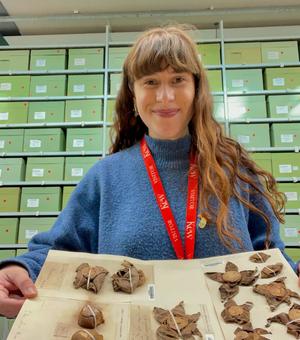Anne-Constance Legros
Please tell us about your research project.
I am a PhD candidate in Early Modern History, at the Center for Advanced Studies in the Renaissance (Tours, France). The thesis I am currently working on, under the supervision of Professor Pascal Brioist, is entitled : “Growing in the undergrowth. A natural history of mushrooms in pre-Linnean botany (1530-1735)”. The undergrowth holds a special place in the collective imagination, as much today as it did in the Renaissance. Renaissance. A magical place par excellence, sometimes monstrous, the forest is the usual environment for many cryptogams, and mushrooms in particular. Mysterious by their very nature, fascinating by their diversity, mushrooms are part of a veritable mythology, linked to their hallucinogenic properties for some, and their ability to make someone pass from life to death for others. However, this symbolic dimension is not the main focus of this thesis. Rather, it's about looking at things in nature and at the nature of things, and more specifically at mushrooms. Through the observation and classification of mycological objects, their iconographic representations (in what is now called Visual Studies), and their comparison with other natural forms—mineral, vegetal, or animal—this study explores Renaissance curiosity about the natural world, as seen in the works of Charles de l’Écluse, Costanzo Felici, and Frans van Sterbeeck. Debates about mushroom reproduction opposed supporters of Aristotle’s spontaneous generation to observers like G. B. della Porta, who defended empirical study of “seeds.” The history of cryptogams remains less developed than that of seed plants, and the epistemology of mycology incomplete. The writings of Carl von Linné later overshadowed the abundance of pre-Linnean work, introducing rigid boundaries between living categories that were far more fluid in earlier thought. A striking example is the 1647 discovery of a petrified mushroom, which baffled contemporary scholars. Long considered part of the plant kingdom, mushrooms are today classified as fungi—an evolution that underscores the shifting perception of life. This thesis combines a botanical and historical approach to explore both the reality of living organisms and their Renaissance interpretations. It presents a cultural and scientific history of these forgotten “plants,” examining the construction of botanical knowledge about mushrooms between 1530 and 1735. Scientific and non-scientific sources alike—pharmacopoeias, dietary texts, and belief systems—reveal tensions between mycophilia and mycophobia. Finally, the discourse on mushrooms is compared to that on other cryptogams (algae, lichens, mosses, ferns) to highlight continuities and ruptures in early modern natural history.
Could you please tell us a bit more about your scholarship/exchange programme?
I am currently at the Maison Française d’Oxford thanks to a one-month scholarship awarded for the month of October. This opportunity is truly unique, as it allows me to pursue my thesis research in an exceptional academic environment and to access key archival materials directly related to my work. During this period, I am consulting documents preserved in the Bodleian Libraries and in several College archives here in Oxford, as well as in London and Kew. Being based at the Maison Française d’Oxford also gives me the chance to interact with a vibrant community of researchers from various disciplines and backgrounds. These exchanges are extremely stimulating and have already helped me to open up new perspectives for my project, particularly in terms of methodology and comparative approaches. More broadly, this scholarship enables me to take part in the dynamic intellectual environment that Oxford offers for the history of science. Engaging with other scholars working on related topics has been invaluable, both for refining my own questions and for situating my research within a wider historiographical framework. Overall, this experience is a significant step forward in my academic path, combining archival research, interdisciplinary dialogue, and immersion in an inspiring research community.
First impressions of Oxford/the University?
My first impression of Oxford is that it’s a small yet remarkably vibrant city, set within a beautiful natural environment. There’s a unique balance here between the academic world, cultural life, and a certain sense of serenity that makes it an ideal place for research — both to focus deeply and to broaden one’s academic circle. What stands out most is how the city’s long scholarly tradition continues to shape its atmosphere today, making it a truly inspiring setting for academic work. At the Maison Française d’Oxford in particular, I’ve been especially struck by the sense of community and intellectual openness. There is a real spirit of curiosity and exchange that brings together researchers from very different fields, offering a rare opportunity to meet and collaborate with scholars beyond one’s own discipline — something that has been one of the most enriching aspects of my experience so far.




